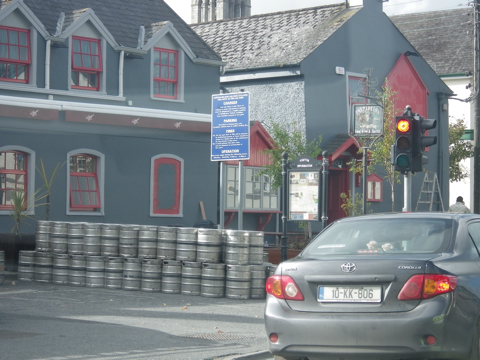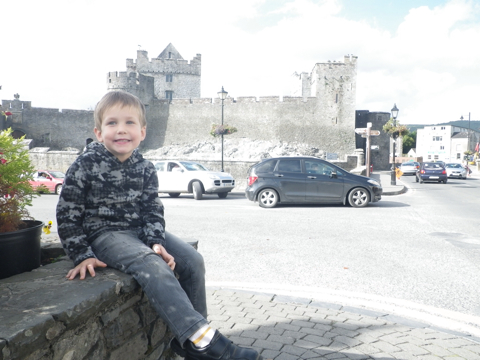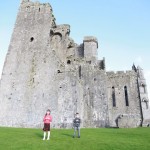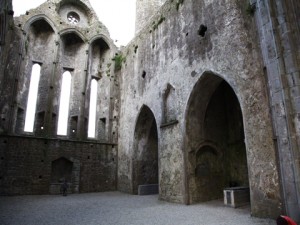I doubt I’d ever get bored exploring a new castle…the children, however, probably have a limit. Bless them, however, since they seem gracious enough to find other was to occupy themselves when bored with the tour guide, even if means playing with wrestler figures on top of the grave of a revered 16th century bishop.
On the way to County Tipperary, we were taken over by a large black truck with a gold harp on the door. Yes…the Guiness truck. On its flatbed stood dozens of kegs of the sacred brew. I could do little but reverentially let it pass, out of respect for the thousands of thirsty Irishmen, waiting for this urgent delivery. Later, we came across one such lucky recipient of the mercy shipment.

Beer is taken seriously here.
Our first stop was Cahir Castle in the village of, you guessed it, Cahir (pronounce Care). It’s a fine castle, with 2m thick walls and was originally built as a Norman keep (the square part). It was ideally sited, on an island with a string river flowing around it. It endured many battles and sieges but because of its strategic location and good design, it stayed in the same hands for a long time. The powerful family of Anglo-Norman lord-baron Butler kept it from 1375 to 1599 when, sadly, technological leaps in weaponry made most castle defenses rather obsolete. After a three-day siege and sustained attacks from the Earl of Essex’s artillery, the Butlers gave up the castle but retook it several decades later. Cromwell visited in 1650 and only had to show them his two cannons to provoke the second abandonment of the castle by the Butlers. They retook again but lost the whole thing to the state when the last Baron died in 1961 without an heir.

One of the more fascinating facts we learned was the function of the squarish tower called the “garde-robe”. It’s basically a small (roughly 3m x 3m interior) stone tower which serves two purposes: first, you hang up your clothes here. Second, you and some of your closest friends sit on the grill and, uh, do your business. The grill is actually a stone pit which, over time, releases ammonia as a byproduct of…well, whatever. And this kills all the bacteria, lice and other nasties that might accumulate on your clothes, since, at that time, you only needed to bathe once a year. Upon hearing this, I could hear Tom piping up …”Papa?…” uh, no Tom…you can’t only take one bath a year.”
Moving north, we made our way to “The Rock”…no, not the wrestler…the Rock of Cashel, otherwise known here as Carraig Phádraig, meaning Patrick’s Rock. This is one of the most historic sites in Ireland and is as impressive as it is important. This is where St. Patrick converted the first Irish King to Christianity, the famous King of Leinster, the most powerful of the region.

We got a bit lost on the way and ended up on a hillside and had to take a small cowpath down to where the GPS said we needed to be. Then we spotted the Rock in the distance…can you spell “awe”? I can only imagine the fear/admiration/respect this structure would have imposed on 13th and 14th century villagers and travelers.
 Once parked and in the tour stream, we learned of how one of the finest cathedrals of Europe was built here, how the bishop had hidden passageways in the stone walls in case an escape was needed. Of the restoration work, only the choir house has been fully restored to the period and they are currently working on the roof of the chapel. The chapel is amazing…a blend of romanesque and celtic symbolism, with faded frescoes that hint at some great works of art. Inside the cavernous cathedral, with its two chapel and 40 foot vaulted ceilings, is a largely gravel floor concealing the stone floor where, 500 years ago, thousands of villagers sought the sanctuary of the church against an invading army. The doors of the cathedral kept the marauders at bay but they put ladders to the church windows and eventually breached the interior. Every man, woman and child was killed.
Once parked and in the tour stream, we learned of how one of the finest cathedrals of Europe was built here, how the bishop had hidden passageways in the stone walls in case an escape was needed. Of the restoration work, only the choir house has been fully restored to the period and they are currently working on the roof of the chapel. The chapel is amazing…a blend of romanesque and celtic symbolism, with faded frescoes that hint at some great works of art. Inside the cavernous cathedral, with its two chapel and 40 foot vaulted ceilings, is a largely gravel floor concealing the stone floor where, 500 years ago, thousands of villagers sought the sanctuary of the church against an invading army. The doors of the cathedral kept the marauders at bay but they put ladders to the church windows and eventually breached the interior. Every man, woman and child was killed.